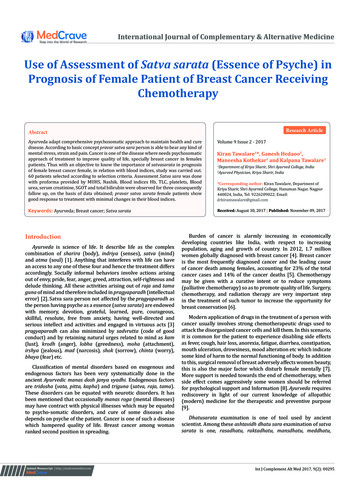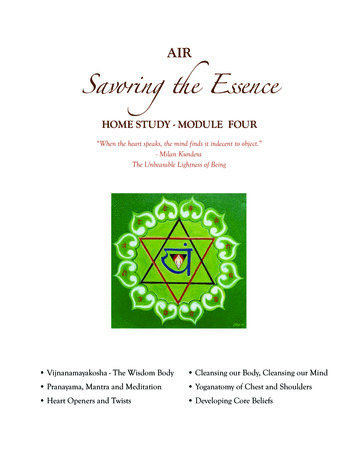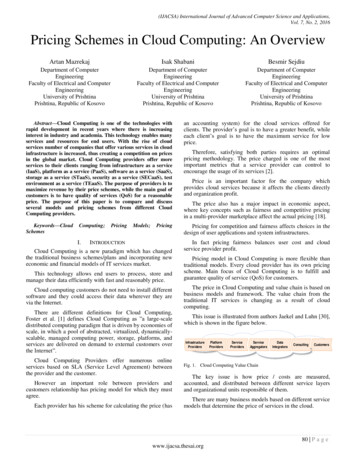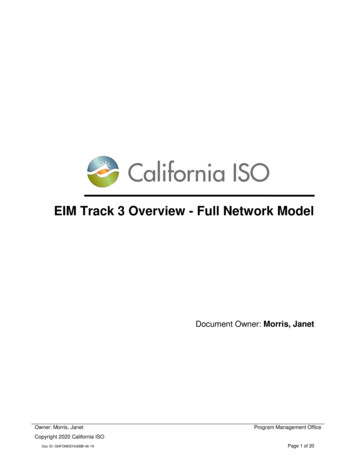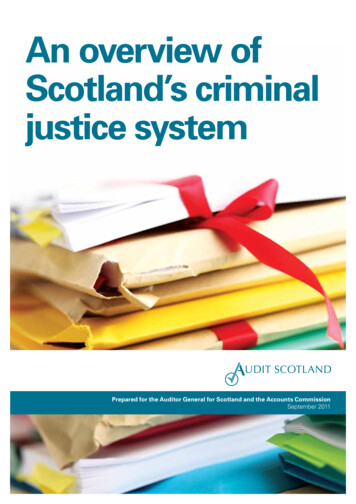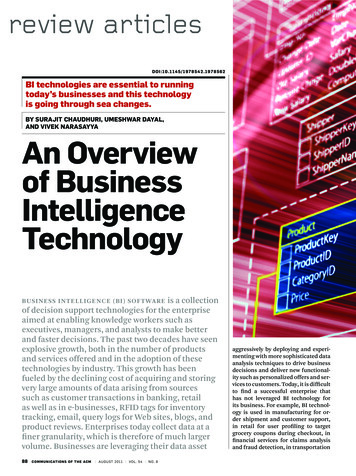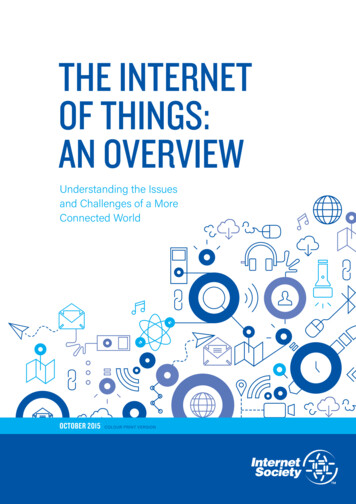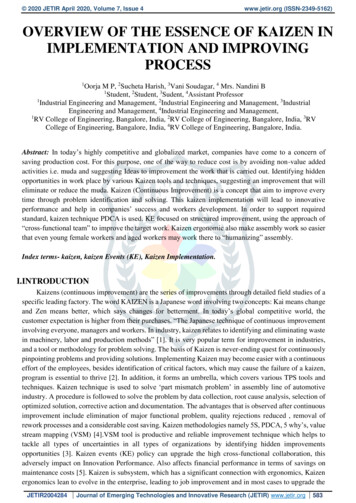
Transcription
2020 JETIR April 2020, Volume 7, Issue 4www.jetir.org (ISSN-2349-5162)OVERVIEW OF THE ESSENCE OF KAIZEN INIMPLEMENTATION AND IMPROVINGPROCESS1Oorja M P, 2Sucheta Harish, 3Vani Soudagar, 4 Mrs. Nandini B1Student, 2Student, 3Sudent, 4Assistant Professor1Industrial Engineering and Management, 2Industrial Engineering and Management, 3IndustrialEngineering and Management, 4Industrial Engineering and Management,1RV College of Engineering, Bangalore, India, 2RV College of Engineering, Bangalore, India, 3RVCollege of Engineering, Bangalore, India, 4RV College of Engineering, Bangalore, India.Abstract: In today’s highly competitive and globalized market, companies have come to a concern ofsaving production cost. For this purpose, one of the way to reduce cost is by avoiding non-value addedactivities i.e. muda and suggesting Ideas to improvement the work that is carried out. Identifying hiddenopportunities in work place by various Kaizen tools and techniques, suggesting an improvement that willeliminate or reduce the muda. Kaizen (Continuous Improvement) is a concept that aim to improve everytime through problem identification and solving. This kaizen implementation will lead to innovativeperformance and help in companies’ success and workers development. In order to support requiredstandard, kaizen technique PDCA is used. KE focused on structured improvement, using the approach of“cross-functional team” to improve the target work. Kaizen ergonomic also make assembly work so easierthat even young female workers and aged workers may work there to “humanizing” assembly.Index terms- kaizen, kaizen Events (KE), Kaizen Implementation.I.INTRODUCTIONKaizens (continuous improvement) are the series of improvements through detailed field studies of aspecific leading factory. The word KAIZEN is a Japanese word involving two concepts: Kai means changeand Zen means better, which says changes for betterment. In today’s global competitive world, thecustomer expectation is higher from their purchases. “The Japanese technique of continuous improvementinvolving everyone, managers and workers. In industry, kaizen relates to identifying and eliminating wastein machinery, labor and production methods” [1]. It is very popular term for improvement in industries,and a tool or methodology for problem solving. The basis of Kaizen is never-ending quest for continuouslypinpointing problems and providing solutions. Implementing Kaizen may become easier with a continuouseffort of the employees, besides identification of critical factors, which may cause the failure of a kaizen,program is essential to thrive [2]. In addition, it forms an umbrella, which covers various TPS tools andtechniques. Kaizen technique is used to solve ‘part mismatch problem’ in assembly line of automotiveindustry. A procedure is followed to solve the problem by data collection, root cause analysis, selection ofoptimized solution, corrective action and documentation. The advantages that is observed after continuousimprovement include elimination of major functional problem, quality rejections reduced , removal ofrework processes and a considerable cost saving. Kaizen methodologies namely 5S, PDCA, 5 why’s, valuestream mapping (VSM) [4].VSM tool is productive and reliable improvement technique which helps totackle all types of uncertainties in all types of organizations by identifying hidden improvementsopportunities [3]. Kaizen events (KE) policy can upgrade the high cross-functional collaboration, thisadversely impact on Innovation Performance. Also affects financial performance in terms of savings onmaintenance costs [5]. Kaizen is subsystem, which has a significant connection with ergonomics, Kaizenergonomics lean to evolve in the enterprise, leading to job improvement and in most cases to upgrade theJETIR2004284Journal of Emerging Technologies and Innovative Research (JETIR) www.jetir.org583
2020 JETIR April 2020, Volume 7, Issue 4www.jetir.org (ISSN-2349-5162)working conditions of developer, which increases employee satisfaction and company productivity,leading to higher productivity. It is a method based on the cycle SDCA (Standardize, Do, Check and Act)[6]. Kaizens serves to elude harmful “them” and “us” relationship at the shop floor, caused by top downprocess. Kaizen ergonomic has made assembly work so easier that even young female workers and agedworkers may work there to “humanizing” assembly [7]. Kaizen consider workers of organization shouldpersistently think over improving and maintaining improvement achievements in their own organization[8].II.LITERATURE REVIEW2.1 KaizenGemba Kaizen details both top managers and bottom workers improvement and requires relativelylittle expense. The kaizen philosophy assumes the life’s way it is mainly focused on constant improvementefforts. Kaizen is a continuous improvement it fights for improvement in our daily normal working andpersonal life. This concept is widely used and exercised in all sphere of life in Japan and other industriallydeveloped countries of the world. Kaizen benefits the performance improvement of the organization in theform muda elimination, machine breakdown reduction, setup time and lead time, balancing the load i.e.yamazumi and human resource development which helps in fundamentals knowledge and fundamentalskill improvement [1]. This has a low cost of improvement and is practical approach [2].2.1.1 Fundamental elements of KaizenThe foundation elements of Kaizen [1] as given by Imai (1986) are mentioned below:i.Teamwork.ii.Self-disciplineiii.Improved moraleiv.Quality circlesv.Improvement related suggestionsvi.Elimination of waste (muda) and inefficiencyvii.The Kaizen 5S framework for good housekeeping.viii.Process standardization2.1.2 Types of KaizensAccording to Imai (1997), Kaizen may be of following types:a.Individual versus Team Kaizen: these are the Kaizens in which the individual employees identifiesimprovement areas in daily work activities and suggest idea for improvement known as Teian Kaizen.b.Day to day versus special event Kaizen: work team identifies the hidden opportunities and find outthe root cause to suggest and develop a new kaizen for work place.c.Process level versus sub process level Kaizen: at sub process levels the improvement at componentlevel work processes are made and radicle changes for betterment of organization.2.1.3 Kaizen Techniques under Kaizen UmbrellaThe Kaizen umbrella consists of various collections of kaizen tools and techniques (Imai, 1986): Customer orientation Kanban Just-in-time Zero defects New product development Small group activities Productivity improvement Statistical Quality Control Total Quality ControlJETIR2004284Journal of Emerging Technologies and Innovative Research (JETIR) www.jetir.org584
2020 JETIR April 2020, Volume 7, Issue 4www.jetir.org (ISSN-2349-5162) QC Circles Automation Discipline at the workplace Total Productive Maintenance Cooperative labour /management relationsFigure.1.Kaizen Umbrella2.1.4Brief description of various kaizen tools and techniques [1]1.Single Minute Exchange Dies: This technique mainly focuses on the reduction of set-up times. This mainlypertains to changeover of die, unclamping and clamping of work piece/die on the machine.2.Total Productive Maintenance: TPM is a preventive maintenance system that is used to enhance theequipment efficiency throughout the working life of the machine. Preventive and corrective maintenanceinitiative must be taken by management and its workers as it empowers them.3.Kanban: Kanban is basically a box/container designed to hold a Kanban card. The Kanban card is movedfrom workstation to store based on the daily requirement and it is a green signal for store to send thematerial to workstation for processing. Work in process inventory was reduced drastically by Toyota motorafter introducing Kanban system.4.5S Practice: This is basically a housekeeping technique .the 5S represents 5 words in the Japanese languageand they are;i.Seiri (sort out): All the irrelevant items at the workplace has to removed or sorted out.ii.Seiton (set in order): The items should be arranged in an orderly manner so that it can be accessed easily.iii.Seiso (Shine): The work place has to be cleaned in such a manner that no dirt is found,iv.Seiketsu (standardize): A standardized work practices should be developed and maintained.v.Shitsuke (sustain): To attain success in 5S, discipline should be inculcated. The progress made in the abovefour points should be adhered.JETIR2004284Journal of Emerging Technologies and Innovative Research (JETIR) www.jetir.org585
2020 JETIR April 2020, Volume 7, Issue 4www.jetir.org . 5S Practice5.Poke Yoke/Jidoka: The purpose of the poke yoke to achieve error proofing of the entire process. It makessure proper condition exists before the process is performed. This not only prevents defects to occur butit also detects and eliminates the defects in the process. Reliability of the process is ensured.6.Standardized Work: A work where all the activities are properly structured so that it can be done in themost efficient manner is called standardized work. It aims to bring the process by reducing the variation.This helps to eradicate wastages and in turn increases productivity.7.Value Stream Mapping: A value stream map is a flowchart depicting all the activities requires to bring aproduct from raw material to delivery to the customer. Its main agenda is to identify and eliminate all thewastes in the process.8.Takt time: Takt time is the time taken from the receiving order from customer to handing over theproduct to customer. This time should minimized through reduction of waste and other unwantedactivities in the process.9.Standard Operating Procedure: This focuses on standardizing all the operating procedures for comparingand creating scope for further improvements.10.Kaizen Blitz/Kaizen Event: Kaizen blitz or kaizen event involves cross functional teams for smallincremental improvements projects.11.7 wastes: The 7 wastes include transportation, waiting, overproduction, defective parts, inventory,movements and excessive processing.2.2 Rules of Kaizens[9]Rule 1: Kaizen is process oriented. Improvisation of the process has to be done for attainment of excellentresults. Improvements in manufacturing process can be effectively done when the management initiatesthe drive to do it. Along with improving the process, other activities and linkages has to be given equalpriority as it also contributes equally to the end result. Improvisation can be effectively done with theinvolvement of the employee. Adequate training should be provided to employees to enhance their skillset.Rule 2: Continuous improvement and maintain standards. Second rule conglomerates the innovation andthe continuous ongoing efforts. Maintaining an improved standard continuously is essential. Smallimprovements contributes to make a significantly large difference wholly. The management has tocontinuously check whether the employee is adhering and working within the established standards, toensure this discipline has to be enforced. PDCA problem solving techniques can be used to support therequired standards. This is a simple and has being helping in continuous improvement. To make theJETIR2004284Journal of Emerging Technologies and Innovative Research (JETIR) www.jetir.org586
2020 JETIR April 2020, Volume 7, Issue 4www.jetir.org (ISSN-2349-5162)improvements measurable and visible, quality enhancement tools can be looped along with PDCA.Improvements and standardized work on a routine basis should be linked.Rule 3: People Orientation. Every employee be it management or worker on machine should havededication and involve completely in the improvement process. For a long run success in the company,management has to instill desires and belief amongst people so as to create successful kaizen.III.KAIZEN EVENTSKaizen Events are the practices that lead to Continuous Improvement and can supports inestablishment of innovative performance. These kaizen events benefits both workers and the companyperformance by improving the work environment. KE focused on a structured improvement project, usingthe approach of “cross-functional team” to improve the target work area, with specific targets [5]. KaizenEvents are one of the effective tool to alter the work culture, work proceeding, and work experience. Thereare two types of approaches for kaizen event progress – gradual improvement and other one is improvementbased on innovations [8].Figure.3. Improvement divided into innovation and kaizen [4]KE will help to eliminate mudas by the workers with compete sense of responsibility and punctualitythat is also a tool for improvement and change. There are various factors that affect kaizen events that aremore suitable for automotive industry. Kaizen factors are [5]: Follow-up Activities: this allows the workers a freedom to make any changes and innovation at workplace. This helps to accomplish KE goals. Working Area Impact: this is a complex phenomenon in the organization that has a potential effects ontechnical and social system and understand how work can fit into bigger picture. Employee Skill and Effort: KE improves the knowledge of the employee in managing the organizationin more systematic and successful way.IV.INDUSTRIES KAIZEN PROGRAMRapid technologies development and changing customer orientation are the challenges whichcompany face. Deming’s concept of kaizen as first quality principle through plan-do-check-act (PDCA)cycles. It emphasis on company-wide process of focused and sustained incremental improvement.Incorporation of kaizen into daily normal activities will focus on eliminating wastes, creating standards,and having clean, organized workplace [2]. A successful kaizen comes from its workers and their actions,not from new pieces of equipment and machinery. Top management should be loyal and devoted to thekaizen philosophy to train the employees for the benefits. Workers naturally fear change, especially afterchanging the routine that they are comfortable, and disturbing old practices and following new practices ischallenging to them, which is after and before kaizen implementation process.JETIR2004284Journal of Emerging Technologies and Innovative Research (JETIR) www.jetir.org587
2020 JETIR April 2020, Volume 7, Issue 4www.jetir.org (ISSN-2349-5162)If company drive towards success and profitability, becoming a world-class organization, by setting thevision, mission, commits, and dedicates of the company to develop a long-term kaizen program. Followingare the processes that kaizen can be implemented [2]:1.Kaizen Events: Many organizations consider KE but still unable to create culture that allowschange, and more improvement efforts will support their cultural and financial goals. For conductingkaizen events, top management must devise a long-term strategy and provide the tools necessary for thekaizen teams to be having a final destination. Kaizen events are most effective when everybody works toachieve that vision.2.Kaizen Program: key ingredients that should be considered for kaizen establishment arei.Create and Communicate the Vision.ii.Establish the Kaizen Champion.iii.Communication Boards and Newsletters.3.Kaizen Governing Committee: these are the committee members those are responsible forensuring the achievement of kaizen teams and helping to erase any obstacles that would impede theimprovement efforts.4.Kaizen Team Selection: The key aspects of kaizen is complete participation of all employees fromall levels of the organization. Many organizations fail to recognize the importance of utilizing productionoperators in making decisions. Enthusiastic and dedication to change is essential and should be addressedon the production floor first.5.Kaizen Monthly Meeting: kaizen monthly meeting should be followed in following agendas: Part 1: Discussion of open action items Part 2: Discussion of the last event’s results Part 3: Planning upcoming events6.Training and Accountability: Kaizen governing committee should get trained and then theyshould train the team of employees that they selected for kaizen event7.Moving Forward: Kaizen should be a way to working, and improve continuously upon whatkaizen committee has done and the next step.V.EMPLOYEE SKILL AND TRAININGPerformance employee ideally rely upon factors like employee’s appraisal, employer’s motivation,satisfaction, recompense, disciplinary and development, job security, organizational structure. Kaizenevents can be one platform of knowledge employees in principles, tools and techniques for continuousimprovement. The study that was being carried consists of two sections that is in commercial and aerospacemanufacturers those who used simulation as a help to improve the KE practices [10]. The simulationprocess that is carried can be used to helped to KE practice, the simulation model is also developed tosupport launch other improvement practices, and finding the results with management can be beneficial.Employee training program can be depicted in 5 stages [8]:1.Investment and culture making to prepare employees psychologically for acceptance andcooperation in project implementation.2.Kaizen committee team of 15 members they are responsibility of Kaizen implementation.3.Holding workshop of adornment system and Focus-PDCA with presence of the management,supervisors and members of Kaizen committee4.Implementation of pilot project in acceptance unit5.Following the same system to other units and department and6.Monitoring improvement activitiesJETIR2004284Journal of Emerging Technologies and Innovative Research (JETIR) www.jetir.org588
2020 JETIR April 2020, Volume 7, Issue 4www.jetir.org (ISSN-2349-5162)VI.THE KAIZEN METHODOLOGYThe standard methodology of kaizen can be used in different field like manufacturing, engineeringand other supporting processes. The Fig x illustrates how kaizen is practiced. Kaizen helps in makingpeople understand the waste in the processes and eliminate/reduce them and helps them perform theprocess rapidly. [2]Figure.4. Methodology for Kaizen ImplementationVII.KAIZEN IMPLEMENTATIONGlobalization is increasing in the world economy. Due to this increase in globalization, thecompetition also increases for the company. Therefore the company needs to focus on improving theperformance with respect to cost, quality and delivery. By implementing kaizen we can bring aboutimprovements in terms of cost, flexibility, and productivity and delivery performance.While implementing kaizen the company focuses on involving the Gemba employees to identify and solveproblems related to workplace issues. [11]7.1 Major guidelines for implementing kaizenImai (1986, 1999) [12] highlighted 5 guiding principles for implementation of kaizen.1.First is Process and Result principle. To improve a process, first a Plan-do-check-act (PDCA) cycleis carried out where a target performance is set (plan), then the improvement plan is executed (do), then itis seen that the plan is in control (check) and finally the plan is standardized according to the results (act).Second a standardize-do-check-act (SDCA) cycle is used to rule out any abnormality and to properlymaintain the implemented work procedure.2.Second is the Putting Quality First principle. Majorly a process must be improved in terms ofquality, cost and delivery (QCD). Quality being usually most important depends the characteristics that thecustomer want. Cost is looked upon the perspective of the manufacturing company to increase margins andthe delivery refers to the company being able to deliver the product depending on the varying demand.3.Third is the Hard Data versus Hunches and feelings principles. Since kaizen is used to solveproblem, it is important to gather relevant data and analyze it and not just rely on hunches and feelingswhich is important for continuous improvement.4.Fourth is the Next Process Is Customer principle which means that all individuals within anorganization deal with customers internally or externally and the next process is always a customer.Understanding this will help build a commitment to never give defective pieces or incomplete informationto the next process.5.Fifth principle is visual management. This principle being an integral part of kaizen allows problemto be visible and detected in real time so that a corrective action can be taken and in future similar problemsJETIR2004284Journal of Emerging Technologies and Innovative Research (JETIR) www.jetir.org589
2020 JETIR April 2020, Volume 7, Issue 4www.jetir.org (ISSN-2349-5162)don’t arise. Visual management has three purposes which are making problems visible, staying in touchwith reality and setting targets.7.2A macro view 3 steps framework for implementing kaizen events [20]1)Open meetings: In an interactive meeting a kaizen sensei teaches skills improvement courses.2)Kaizen activities: The self- improvement teams (SIT) are instructed by kaizen sensei about the skillsneeded in implementing the improvement activities and then the SITs implement the improvement events.3)Close meeting: The improvement plans are presented by the SITs in a kaizen seminar where the topmanagement and kaizen sensei confirm and comment on these plan.7.3 Factors for successful implementation.It is important to have a good system present in the company that enables effective communicationbetween top management and the Gemba employees as this will encourage the shop floor employees totell about the process problems and suggest improvement ideas based on the knowledge they have gainedwhile working on the process.( Womach et al, 2007).[11]Having a clear and defined corporate strategy, polices and goals are very important to build an environmentfor enabling a kaizen culture. Having a clear kaizen strategy helps the company allocate enough resourcesto go ahead with the continuous improvement philosophy.It is very important to have a kaizen champion in the company for successful implementation ofkaizens. By having a kaizen championship with deep understanding and commitment to continuousimprovement, the departments can now implement the kaizens more precisely and frequently.A very important factor for implementation is the structure of the organization. It is seen thatcompanies with horizontal structure and supports high degree of self-discipline and autonomy tends to bemore fruitful than other bureaucratic organization. Having cross functional group and problem solvingteams like quality circle working together make kaizen implementation more successful. [11]An input- outcome model can be used to understand the team effectiveness in implementing kaizens asgiven by J.A.Farris (2009) [13] with five basic factor groups. These groups are kaizen event designantecedents, Organizational and work area antecedents, Kaizen event process factors, Social systemoutcomes and Technical system outcomes. [13]A study was done in 2012 [14] on critical factors that affected the successful implementation ofkaizens. After factor analysis it showed that training and education of employees was a major factor witha variance of 10.4885 which shows how much of a difference it can make if the employees are made moreaware to the kaizen process. The next major factor is the communication process (var. 8.712%) which isfollowed by the need for proper documentation and evaluation (Var. 8.164%). Other notable critical factorsfor implementation were workers integration and award, culture for change and improvement, managementcommitment and customer focus. [14]VIII.KAIZEN IN TPS [7]TPS cannot be limited to just in time and jidoka . An efficient method to reduce the production costs,keep up with the production and improve the product quality kaizen is introduced. Kaizens are mainlysmall group activity such as the quality circles or individuals who make some suggestions for improvement.Wormack, Roos, and Jones (1990) introduced the lean production and treated kaizens by the quality circlesto improve the process with the cooperation of shop engineers. Ohno (1990) explains that kaizens areefficient ways to increase the product quality and productivity. Masaaki Imai and Paul Adler (1985)generalizes the notion of kaizens exists in three levels i.e kaizens made by the shop managers and engineers,quality circle and individual worker through a suggestion system. Nummi adler (1998) mentions thebottom up and top down mechanisms in kaizen. Imai (1997) prioritizes the quality improvement kaizenmade by the small groups and individual workers, though giving prominence to the compatibility of qualityimprovement and cost reduction. He also focuses on increase in productivity should be a by-product ofJETIR2004284Journal of Emerging Technologies and Innovative Research (JETIR) www.jetir.org590
2020 JETIR April 2020, Volume 7, Issue 4www.jetir.org (ISSN-2349-5162)quality improvement, thus reducing repair work and mudas. Alder (1998) does not emphasis on top-downappoach as NUMMI is focusing on the bottoms up approach. According to Imai (1986) 50% of supervisorystaff’s task was to spend for kaizens and if 90% is from the engineers and the staff, the top-downmechanism and their kaizen activities should be understood properly.IX.KAIZEN COSTINGKaizen costing is the system used to reduce cost in an already existing manufacturing phase of aproduct. This system therefore comes after the target costing of the engineering phase. Therefore thissystem focuses on making improvements in the manufacturing processes of existing produce to reduce thecost. Kaizen costing is a part of overall cost control system used outside the standard costing system.Kaizen costing is used outside standard costing to eliminate the limitations presented by the standardcosting and therefore it gives room for focusing on improvement of processes to increase profit. Kaizencosting has two types. [15] The first one deals with the phase when the difference between the target andactual cost is huge after new product is in production for 3 months. The other one refers to the continuallyimplemented activities to reduce difference between actual and target cost every period to achieveallowable cost. Implementing regular kaizen events results in the achievement of target kaizen cost.Target kaizen cost in this period Estimated amount of actual cost * target ratio of cost decrease amountto estimated cost.X.RESEARCH METHODOLOGYIndian Small-scale industries have implemented kaizen mainly process wise. In our project we firstconducted a literature review and visited the industry. The data of the process were collected and thenanalyzed. After finding out the problems in the analysis stage, Kaizens are proposed for improvement ofthe process. The kaizen events are then implemented. Data after implementation is collected and analyzed.Finally, the conclusion of kaizen events is made. [9]Figure.5. Kaizen Methodology followed in case studyJETIR2004284Journal of Emerging Technologies and Innovative Research (JETIR) www.jetir.org591
2020 JETIR April 2020, Volume 7, Issue 4www.jetir.org (ISSN-2349-5162)A similar methodology was followed by us in our time in XYZ organization. The XYZ organizationmainly supply to companies that follow lean methodology and therefore the company also follows leanmethodologies.After industrial visit we collected data on all the assembly lines. We then selected an assembly lineproducing inside handles because it had the most demand and the production could not match it, so extrashifts were held regularly.[16]Inside handle assembly Line:-Figure.6. KIA inside handle assembly work stations10.1 Analysis of current conditionWe used standard work TPS tools like SOS (Sequence of operation), SWC (Standard work chart) andSWCT (Standard work combination table) [17] to collect data and analyze the assembly line. Followingwere the findings:Daily Target 2640 pieces/dayTakt time 20 secondsTable.1. Cycle time and Machine time of all 3 stations in assembly lineStationStation 116Machinetime(seconds)0Station 2198Station 3131Offline Station50JETIR2004284Cycle time(seconds)Journal of Emerging Technologies and Innovative Research (JETIR) www.jetir.org592
2020 JETIR April 2020, Volume 7, Issue 4www.jetir.org (ISSN-2349-5162)Table.2 – Shows the list of Muda in the assembly line10.2After analyzing the assembly line these were the major issues: The non-value added time is huge due to transport. Man and machine is not used effectively in station 2. Excessive movement in station 1 due to layout. Load not balanced properly between the members.10.3 Improvement plan:Kaizen Events: To reduce the wastes in the assembly line, several kaizen events were implemented.These kaizen events are:a)5 kaizen events were implemented that changed the layout of station 1 to reduce movement andcycle time of the station.b)The inventory storage of raw material and bins was now placed in a rack right next to station 1.This reduced the major non-value added time of transport as the raw materials were right next to the station.c)The length of the chute was increased to reduce defects.d)To balance the workload and to increase the man-machine efficiency, the offline workstation wasremoved and those operations were added to station 1 and station 2. [18]After the implementation of kaizenevents in station 1(which reduced its cycle time), the new set of operations were practiced for an hour for20 days and then finally implemented.JETIR2004284Journal of Emerging Technologies and Innovative Research (JETIR) www.jetir.org593
2020 JETIR April 2020, Volume 7, Issue 4www.jetir.org (ISSN-2349-5162)Table.3 Analysis of assembly line after implementing first 3 sets of kaizen events. The cycle time of worktable 1 is reduced by 3 seconds. 15 minutes of incidental ti
Kaizen ergonomic also make assembly work so easier that even young female workers and aged workers may work there to “humanizing” assembly. Index terms- kaizen, kaizen Events (KE), Kaizen Implementation. I.INTRODUCTION Kaizens (continuous improvement) are the s

